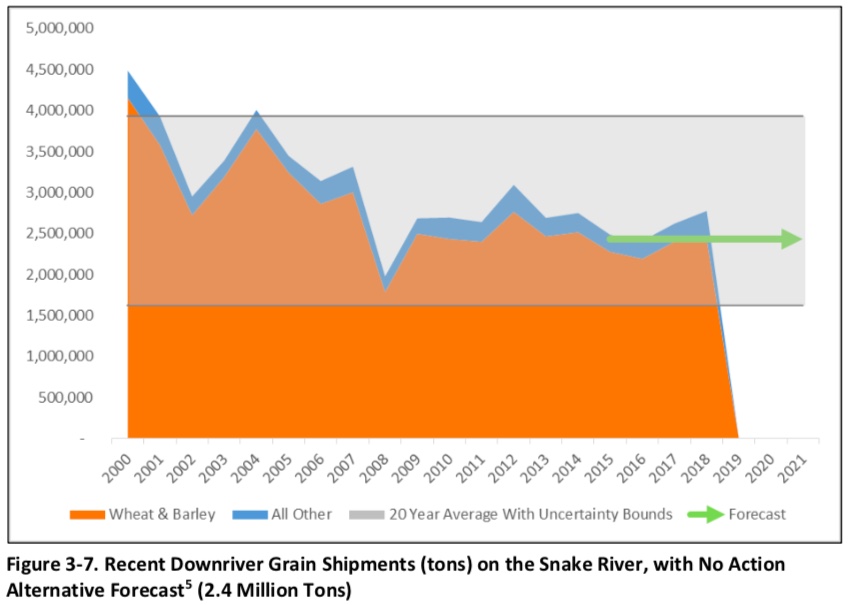forum
library
tutorial
contact

Port of Lewiston a Major Benefit
to Nez Perce County Farmers
by Sean Ellis
Quarterly, Spring 2023
|
the film forum library tutorial contact |

|
Port of Lewiston a Major Benefit
by Sean Ellis
|
The Port of Lewiston is crucial to the region's agricultural community because
it gives producers a competitive freight advantage that it otherwise wouldn't have.
LEWISTON -- When it comes to agriculture, wheat is king in Nez Perce County.
But the county is very diverse geographically and plenty of other crops are produced there as well.
And anchoring the county's agricultural industry is the Port of Lewiston, which provides farmers in the region an efficient and cost-effective way to ship their wheat and other ag products to overseas markets.
"Winter wheat is the predominant crop in Nez Perce County," says Robert Blair, who farms near Kendrick.
But, he adds, the county is very diverse geographically. For example, elevation around Lewiston, the county seat, is about 800 feet above sea level, while its' closer to 4,000 feet in some other farming areas in the county.
The Lewiston area gets roughly 10-12 inches of rain per year while other areas of the county receive 25-plus inches, says Blair, former president of Nez Perce County Farm Bureau. And the Lewiston area has sandy soils, while heavier clay soils are predominant in the higher elevations.

"Nez Perce County is very diverse geographically," he says.
That's the reason a variety of crops are able to be produced in Nez Perce County, which has 446 farms and 381,587 total acres of land in farming, according to the 2017 Census of Agriculture.
"We have wheat and barley, garbanzo beans, lentils, peas, canola, alfalfa, and there's a lot of Timothy hay exported from the area," says NPCFB President Dale Wolff, who farms and ranches near Kendrick.
The backbone of the county's and region's agricultural industry is the Port of Lewiston, where bulk ag commodities can be loaded onto barges and moved down river to West Coast ports for export.
"It's a vital part of the county. I can't imagine life here without it," Wolff says about the port, which is the furthest inland seaport in the United States. "We've built our economy here in Nez Perce County around that river system. It's staggering how much of our economy the river system supports."
The port is crucial to the region's agricultural community because it gives producers a competitive freight advantage that it otherwise wouldn't have, says Blair.
"The port is huge both in moving farming products down the river to global markets and to get our inputs, like fertilizer, coming in through Lewiston at reduced rates," he said.
Cattle and calves also play a significant role in the county's agricultural portfolio. According to the 2017 ag census, there were 13,000 head of cattle in the county during the 2017 census year and that industry brought in $13 million in farm-gate revenue.
"There is a significant amount of rangeland in the county where cattle grazing is the main use because of steep slopes and poorer soils," says Bob Smathers, Idaho Farm Bureau Federation's regional field manager for North Idaho.
The economies of rural areas in the county are primarily based on farming, livestock and forestry, Smathers says, "In fact, Nez Perce County's overall economy is rooted in agriculture."
According to the 2017 Census of Agriculture, there were 105,449 acres of wheat produced in the county during the 2017 census year, 44,982 acres of garbanzo beans, 14,538 acres of hay, 6,247 acres of lentils and 6,116 acres of barley for grain.
Ninety-three percent of the farms in Nez Perce County are family farms, according to the census, and 8 percent of them sell directly to consumers.
There are a lot of very small farms in the county. According to the ag census, 117 of the county's farms are 9 acres or less in size and 191 of them had sales of $2,500 or less in 2017.
But there are still plenty of bigger farms in Nez Perce County. According to the ag census, 108 farms in the county were 1,000 acres or more in size in 2017 and 112 of them had sales of $100,000 or more.
One of the main focuses of the Nez Perce County Farm Bureau organization is reaching youth with the message of agriculture and making sure they receive the real facts about farming and ranching, Wolff says.
"We support all of our locally youth programs, such as 4-H and FFA," he says. "Most people are generations away from the farm now and there are fewer and fewer of us involved in farming. If we don't educate those kids in town where their food comes from, then they'll be susceptible to all the gobbledygook that's being fed to them by (anti-agriculture groups)."
Wolff says another big focus of the local Farm Bureau organization is trying to preserve the great way of life that has made Idaho the fastest-growing state in the nation percentage-wise.
One way the group is trying to do that is through a TV commercial that encourages newcomers, as well as long-time residents, to keep Idaho, Idaho.
The commercial scrolls through farming and ranching pictures and video while telling people to remember why the moved here.
"The intent of the commercial is to tell people, there's a reason why you're coming here. Leave it alone," Wolff says. "I also want everyone to know Farm Bureau is working to keep Idaho, Idaho. It's a good message."
learn more on topics covered in the film
see the video
read the script
learn the songs
discussion forum
